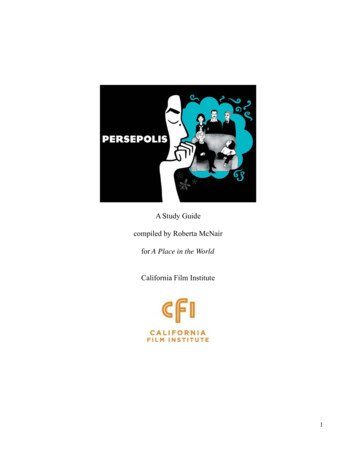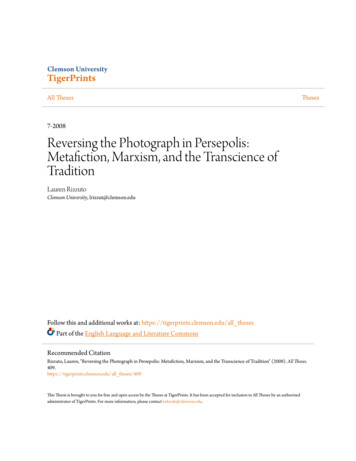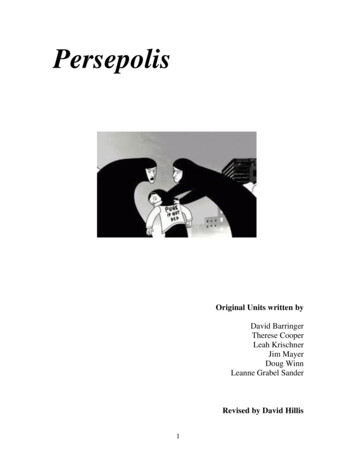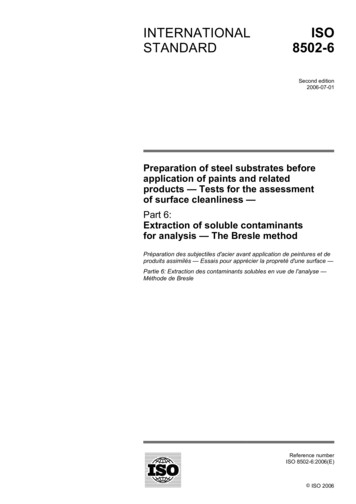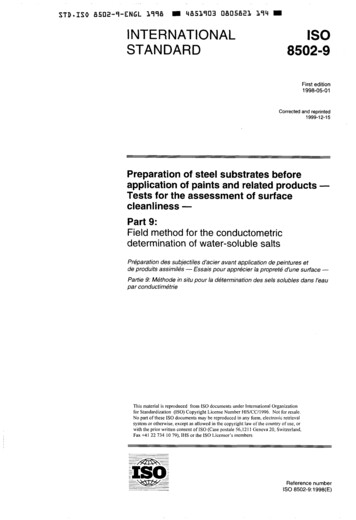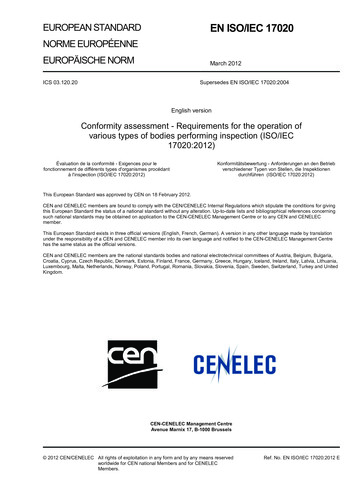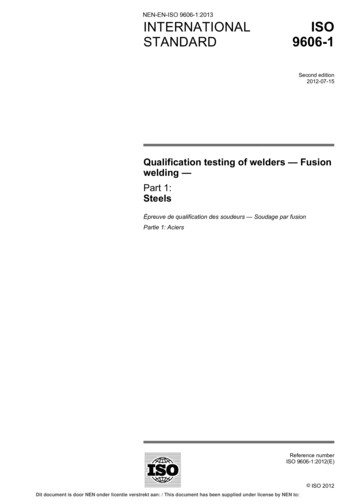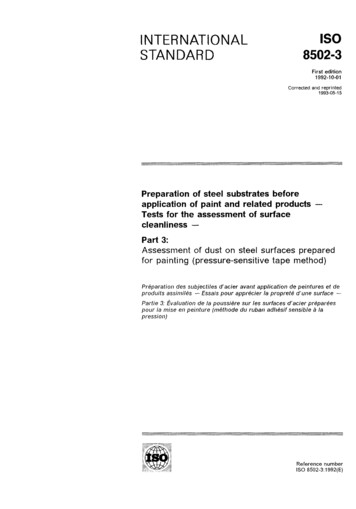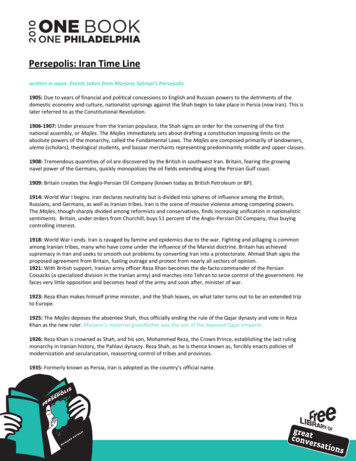
Transcription
Persepolis: Iran Time Linewritten in aqua: Events taken from Marjane Satrapi’s Persepolis1905: Due to years of financial and political concessions to English and Russian powers to the detriments of thedomestic economy and culture, nationalist uprisings against the Shah begin to take place in Persia (now Iran). This islater referred to as the Constitutional Revolution.1906-1907: Under pressure from the Iranian populace, the Shah signs an order for the convening of the firstnational assembly, or Majles. The Majles immediately sets about drafting a constitution imposing limits on theabsolute powers of the monarchy, called the Fundamental Laws. The Majles are composed primarily of landowners,ulema (scholars), theological students, and bazaar merchants representing predominantly middle and upper classes.1908: Tremendous quantities of oil are discovered by the British in southwest Iran. Britain, fearing the growingnavel power of the Germans, quickly monopolizes the oil fields extending along the Persian Gulf coast.1909: Britain creates the Anglo-Persian Oil Company (known today as British Petroleum or BP).1914: World War I begins. Iran declares neutrality but is divided into spheres of influence among the British,Russians, and Germans, as well as Iranian tribes. Iran is the scene of massive violence among competing powers.The Majles, though sharply divided among reformists and conservatives, finds increasing unification in nationalisticsentiments. Britain, under orders from Churchill, buys 51 percent of the Anglo-Persian Oil Company, thus buyingcontrolling interest.1918: World War I ends. Iran is ravaged by famine and epidemics due to the war. Fighting and pillaging is commonamong Iranian tribes, many who have come under the influence of the Marxist doctrine. Britain has achievedsupremacy in Iran and seeks to smooth out problems by converting Iran into a protectorate. Ahmad Shah signs theproposed agreement from Britain, fueling outrage and protest from nearly all sectors of opinion.1921: With British support, Iranian army officer Reza Khan becomes the de-facto commander of the PersianCossacks (a specialized division in the Iranian army) and marches into Tehran to seize control of the government. Hefaces very little opposition and becomes head of the army and soon after, minister of war.1923: Reza Khan makes himself prime minister, and the Shah leaves, on what later turns out to be an extended tripto Europe.1925: The Majles deposes the absentee Shah, thus officially ending the rule of the Qajar dynasty and vote in RezaKhan as the new ruler. Marjane’s maternal grandfather was the son of the deposed Qajar emperor.1926: Reza Khan is crowned as Shah, and his son, Mohammed Reza, the Crown Prince, establishing the last rulingmonarchy in Iranian history, the Pahlavi dynasty. Reza Shah, as he is thence known as, forcibly enacts policies ofmodernization and secularization, reasserting control of tribes and provinces.1935: Formerly known as Persia, Iran is adopted as the country’s official name.
1941: Despite having declared neutrality during World War II, the Shah’s close ties with Nazi Germany compelsEnglish and Soviet forces to occupy western Iran, driving the Shah out. His son, Mohammed Reza Pahlavi, becomesthe new Shah. Soviet forces continue to mount and support insurgency; Iranian-Marxists succeed in establishingpro-Soviet separatist regimes in Azerbaijan and Kurdistan. Marjane’s great uncle Ferrydoon was one of theseparatist leaders who declared independence for the province of Azerbaijan; her uncle Anoosh served under himas his secretary.1946: With support from the U.S. and U.N., the Shah’s forces succeed in forcing the Soviet Union to withdraw theirforces from the separatist provinces, thereby defeating the pro-Soviet Tudeh Party. Marjane’s uncle Ferrydoon isexecuted in this defeat, and her Uncle Anoosh flees to the U.S.S.R.1951: Following the assassination of Ali Razmara after just nine months in office, nationalist MohammedMossadegh is declared prime minister. Enjoying strong public and political support, Mossadegh nationalizes the oilindustry. In response, Britain imposes an oil embargo and blockade of oil exports, which cripples the Iranianeconomy.1953: U.K. and U.S. intelligence services engineer a coup during which the Shah’s forces arrest Prime MinisterMossadegh. General Fazolollah Zahedi, a monarchist, is declared the new prime minister. The Shah, having fled Iran,now returns to power.1960: Iran, along with Iraq, Kuwait, Saudi Arabia, and Venezuela, found the Organization of Petroleum ExportingCountries (OPEC) to consolidate power over the oil industry, a main financial resource for all the countries.1961: The Shah embarks on a succession of economic, social, and administrative reforms, pushed by the KennedyAdministration, that are known as the Shah’s “White Revolution.” These reforms greatly focus on land reforms,privatization of factories, and education measures, which are criticized by the Majles but enjoy great initial supportfrom the populace.1963: Ayatollah Ruhollah Khomeini, a little know cleric, rises to prominence vehemently protesting against theShah’s rule coupled with U.S. domination in Iran, garnering much support from Iranians. He is exiled to France thefollowing year after a particularly aggressive speech against a law effectively granting immunity to U.S. militarypersonnel in Iran.Mid 1960s – Late 1970s: The Shah’s progressively autocratic methods, including his increasing use of SAVAK, thenational intelligence and security force, or secret police (trained by the CIA and Israel’s Mossad) to enact hisreforms as well as his pro-western policies, continue to alienate large sectors of the population, most notably, theShi’a clergy. Thousands of protesters are arrested and killed following demonstrations; many others are imprisonedand tortured by the SAVAK. In Persepolis, Marjane’s parents are frequent protesters at these demonstrations.Friends of her parents, Siamek Jari and Moshen Shakiba, are two of the many protesters imprisoned and tortured.
1978: In response to the Shah’s rule and the notoriously abusive powers of the SAVAK, religious and politicalopposition coalesces into mass riots, strikes, and demonstrations. In Persepolis, one of the most notorious incidentslaid at the feet of the SAVAK is the burning of the Rex Cinema where more than 400 people die. Three weeks afterthat incident, Marjane and her maid, Mehri, erroneously attend a demonstration that is later labeled as BlackFriday; SAVAK gun down hundreds of unarmed protesters who refuse to disperse.1979: The Islamic Revolution begins. As the political situation deteriorates, the Shah and his family are forced intoexile. Exiled religious leader, Ayatollah Khomeini returns from exile to assume control of Iran and is declaredSupreme Leader of the newly established Islamic Republic of Iran, a theocratic republic based on the Islamic faith. InPersepolis, Marjane describes a population that is overjoyed at the exodus of the Shah, but imbued by strangephenomena such as the revamping of school texts, an inexplicably drastic piety in neighbors, the establishment ofHezbollah (fundamentalist street gangs), Revolutionary Committees, and the introduction of the veil.Fundamentalist believers begin orchestrating harrowing events such as the taking of the U.S. embassy and arounding up and execution of ex-revolutionaries, including Marjane’s Uncle Anoosh.1980: The new Islamic Republic of Iran is in is disarray; many factions are divided and the new Iranian government’szeal to rid the country of foreign powers has left it internationally isolated. Iraq, sensing an opportunity to settlehistorical disputes concerning the boundary line of the Shatt al Arab river, which cuts across Shi’a Muslims, Arabs,and Kurds with differing political loyalties, also senses a danger from a newly formed theocracy, which seeks toincite Shi’a Muslims (the majority in Iraq) to similar notions of revolution. Iraq invades Iran. The Iran-Iraq war begins.As Marjane describes in her story, Saddam Hussein’s attack of Iran provoked outrage and an increase in nationalismwithin the people.Early to Mid 1980s: Iran and Iraq attack and counterattack continuously, neither side holding the advantage forlong. Iraq, with aid from other nations in the Middle East, has superior weaponry, but Iran has greater numbers,sending in troops in “waves.” Iranian fundamentalists also use the war effort to further eliminate domesticopposition to the new regime, tightening their hold on power by increasing the presence of Hezbollah, severelyrestricting travel in and out of Iran, and streamlining education to the new religious doctrine. In Persepolis,Marjane, her family, friends, and neighbors, are continuously sent into the basement following bombings, with oneparticular assault killing her neighbors, the Baba-Levys. She recounts the various actions of the Iranian government:how boys were introduced with painted gold keys that would take them to Paradise as a way of recruiting soldiers;how propaganda exalting the status of martyrs as “injecting blood into the veins of society” became commonplace;and how her Uncle Taher, suffering from a heart attack and only wishing to see his son, dies before he can receivepermission to leave the country.1988: Iran, with reluctance, accepts UN resolution 598, which calls for a ceasefire of hostilities between Iran andIraq. Upon her return to Iran from Europe, Marjane’s father recounts the events leading up to the armistice:Iranian mujahideen (combatants) enter Iran to topple the fundamentalist regime but are defeated by the Guardiansof the Revolution and the army. The regime considers the possibilities had the mujahideen succeeded in liberatingthe political prisoners and decide to give these prisoners a choice: renounce their ideas and pledge loyalty to theIslamic regime or be executed. Most choose to be executed.
1989: Ayatollah Khomeini dies. President Khamenei is appointed the new Supreme Leader, a relatively smoothtransition, though there is debate among the senior ulema about Khamenei’s lack of religious qualifications. AliAkbar Hashemi-Rafsanjani is sworn in as the new president, with apparent backing from both reformists andconservatives.1990-1991: Iran remains neutral during Iraq’s invasion of Kuwait, and Iran and Iraq resume diplomatic ties soonafter. Rapprochement with the West remains hindered. The fundamentalist regime continues its repression.Marjane, a student at the university in Tehran, describes her and her friends’ attitudes as being composed of polaropposites. They are model citizens in public, giving the regime no excuse to harass them, but in private they areexuberant individuals, throwing parties nearly every night. One night ends in tragedy, with one friend falling to hisdeath while trying to escape the Guardians of the Revolution. This, more than other events, compels Marjane andher friends not to give in to intimidation and repressive measures.1993: Iran requests heavy water reactors from Russia and is refused, citing nuclear proliferation concerns. The U.S.accuses Iran of conducting a secret arms program following the request. Iran refutes that it has a right to a nuclearenergy program. Repressive measures by the Islamic regime continue. In Marjane’s story, she realizes that shecannot continue to live in such a society and after spending quality time with her loved ones, she leaves Iran onceagain, this time to France.1995: The U.S., under the Clinton Administration, imposes oil and trade sanctions on Iran for their alleged supportof the terrorist activities and their desire for nuclear armament. Iran denies the charges.1997: Mohammed Khatami, a reformist cleric, wins the presidential election with 70 percent of the vote, beatingthe conservative ruling elite and giving hope to a new generation of Iranians for a less restrictive and autocraticregime.1999: Pro-democracy students take to the streets, protesting the closure of “Salam,” a reformist newspaper.Clashes with the regime result in six days of rioting and more than 1,000 arrests.2000: Majles elections: Liberals take control of parliament from conservatives. Following a new press bans law, thejudiciary, bans the publication of 16 reformist newspapers.2001: President Khatami is re-elected.2002: Iran begins construction on their first nuclear reactor, despite U.S. objections. President Bush refers to Iraq,Iran, and North Korea as an “axis of evil” in reference to the long-range missiles being developed among the nations.Iran reacts with outrage, the speech condemned by both conservatives and reformists.2003: Thousands attends student-led protests in Tehran against the regime. U.N. International Atomic EnergyAgency (IAEA) conducts a series of inspections in Iran; Iran confirms construction of nuclear power plants but insiststhey are to be used as a fuel source.
2004: Majles elections: Conservative wrest back control of Parliament, having disqualified reformist candidatesbefore the polls. Following a reprimand from IAEA for failing to fully disclose details about its nuclear plans, Iranagrees to suspend most of its uranium enrichment.2005: Mahmoud Ahmadinejad, the extremely conservative mayor of Tehran, wins the presidential election againstRafsanjani. Iran resumes its nuclear activities, insisting that its activities are not for war purposes; IAEA claims Iranis in violation of the Nuclear Non-Proliferation Treaty.2006: IAEA says Iran has failed to stop its uranium enrichment process, inviting sanctions from U.N. Security Counciland condemnations from Iran who speeds up its uranium enrichment.2007: After failing to meet a new deadline imposed by IAEA, Iran is threatened with new sanctions for its uraniumenrichment. Britain and Iran stand off after Iran detains 15 sailors patrolling the Shatt Al Arab river between Iranand Iraq. The sailors are released a month later after diplomatic negotiations with
In Persepolis, one of the most notorious incidents laid at the feet of the SAVAK is the burning of the Rex Cinema where more than 400 people die. Three weeks after that incident, Marjane and her maid, Mehri, erroneously attend a demonstration that is later labeled as Black Friday; SAVAK gun down hundreds of unarmed protesters who refuse to disperse. 1979: The Islamic Revolution begins. As the .
